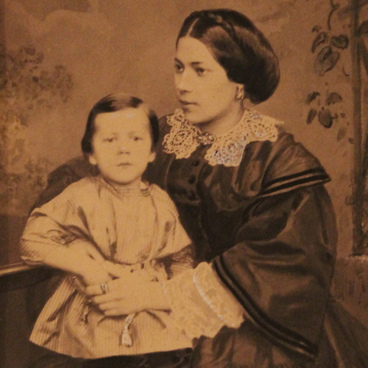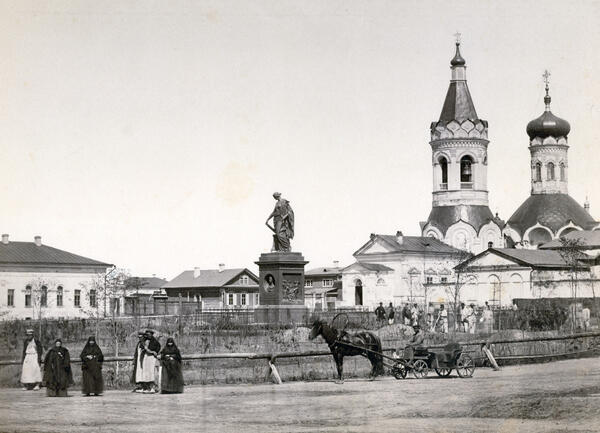‘A View of Saratov from the Volga’, the earliest panorama of the city, was captured by famous military photographer Antonius Murenko. His works are one of the first Russian attempts to capture scientific matter under field conditions with the help of the photographic technique.
Antonius Stephanovich Murenko was born in 1837 in the village of Bogdanovka, Chernigov Governorate. In1855 he joined the military service: he participated in the Crimean War, where he was awarded a bronze medal In Memory of the War of 1853-1856 on the St. Andrew Ribbon.
In 1856, Murenko was assigned to the photography detachment of a Military Topographic Depot. His responsibilities included practical and theoretical study of photography under the guidance of Captain N.G. Pisarevsky: in those days, the daguerreotype photographic process was practically totally replaced with the moist collodion process. Having mastered the new method of photograph processing, Antonius went on an expedition trip. Later, in 1861, he undertook a three-year business trip around Russia to compile albums of ‘views and types’. Upon retirement, he opened a photographic studio in Saratov.
By the mid-19th century, businesses and trade had started to rapidly develop in the Saratov region: commencement of steamship navigation on the Volga contributed to extensive opening of factories and plants that processed local raw materials. Back then in Saratov, beautiful stone churches and public buildings were built, the number of schools and colleges grew, the merchant House and the Public Theatre opened. It was exactly in 1864 that dusty and dreary urban spaces of Saratov started to be landscaped and upgraded.
The picture taken in 1864 highlights the façade of the First Grammar School for boys, the Pypins House, and behind it, in the shade, the house of the Chernyshevskys, Gimnazichesky Uphill Road (now Nekrasova Street), the House of Governor Kozhevnikov and St. Sergius Church, where Chernyshevsky’s father, Gavriil Ivanovich Chernyshevsky served as an arch-priest.
Over 20 years of the life of Nikolay Chernyshevsky were connected with Saratov. He was born and spent his childhood there; he spent two years teaching in the Saratov Grammar School. He visited the city in 1859 and 1861. After his penal servitude, he returned to his native city. Finally, he was buried there, at the Voskresensky Cemetery.
Antonius Stephanovich Murenko was born in 1837 in the village of Bogdanovka, Chernigov Governorate. In1855 he joined the military service: he participated in the Crimean War, where he was awarded a bronze medal In Memory of the War of 1853-1856 on the St. Andrew Ribbon.
In 1856, Murenko was assigned to the photography detachment of a Military Topographic Depot. His responsibilities included practical and theoretical study of photography under the guidance of Captain N.G. Pisarevsky: in those days, the daguerreotype photographic process was practically totally replaced with the moist collodion process. Having mastered the new method of photograph processing, Antonius went on an expedition trip. Later, in 1861, he undertook a three-year business trip around Russia to compile albums of ‘views and types’. Upon retirement, he opened a photographic studio in Saratov.
By the mid-19th century, businesses and trade had started to rapidly develop in the Saratov region: commencement of steamship navigation on the Volga contributed to extensive opening of factories and plants that processed local raw materials. Back then in Saratov, beautiful stone churches and public buildings were built, the number of schools and colleges grew, the merchant House and the Public Theatre opened. It was exactly in 1864 that dusty and dreary urban spaces of Saratov started to be landscaped and upgraded.
The picture taken in 1864 highlights the façade of the First Grammar School for boys, the Pypins House, and behind it, in the shade, the house of the Chernyshevskys, Gimnazichesky Uphill Road (now Nekrasova Street), the House of Governor Kozhevnikov and St. Sergius Church, where Chernyshevsky’s father, Gavriil Ivanovich Chernyshevsky served as an arch-priest.
Over 20 years of the life of Nikolay Chernyshevsky were connected with Saratov. He was born and spent his childhood there; he spent two years teaching in the Saratov Grammar School. He visited the city in 1859 and 1861. After his penal servitude, he returned to his native city. Finally, he was buried there, at the Voskresensky Cemetery.


